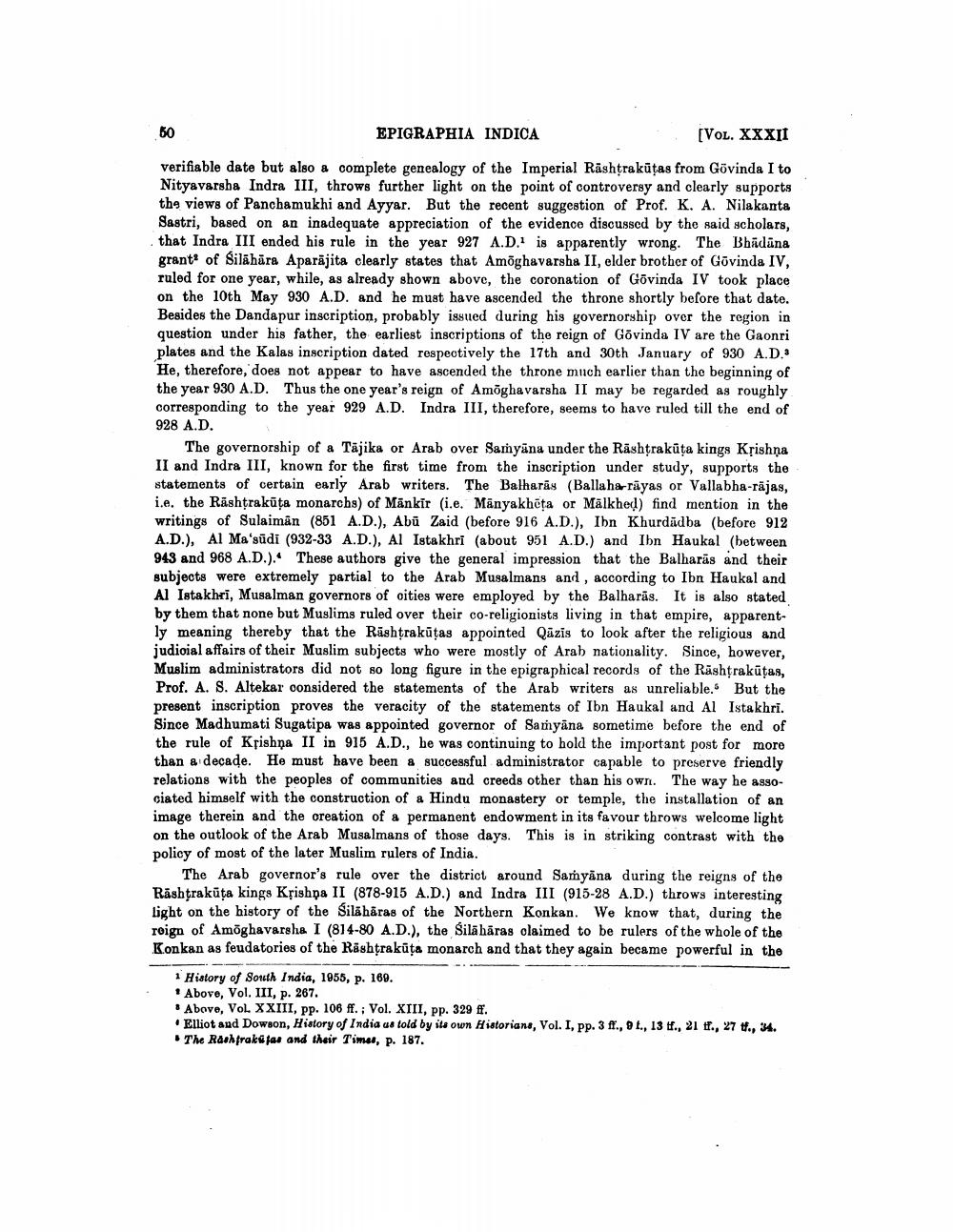________________
50
EPIGRAPHIA INDICA
[VOL. XXXII
verifiable date but also a complete genealogy of the Imperial Rashtrakūtas from Govinda I to Nityavarsha Indra III, throws further light on the point of controversy and clearly supports the views of Panchamukhi and Ayyar. But the recent suggestion of Prof. K. A. Nilakanta Sastri, based on an inadequate appreciation of the evidence discussed by the said scholars, that Indra III ended his rule in the year 927 A.D. is apparently wrong. The Bhadana grant of Silāhāra Aparajita clearly states that Amõghavarsha II, elder brother of Govinda IV, ruled for one year, while, as already shown above, the coronation of Govinda IV took place on the 10th May 930 A.D. and he must have ascended the throne shortly before that date. Besides the Dandapur inscription, probably issued during his governorship over the region in question under his father, the earliest inscriptions of the reign of Govinda IV are the Gaonri plates and the Kalas inscription dated respectively the 17th and 30th January of 930 A.D.: He, therefore, does not appear to have ascended the throne much earlier than the beginning of the year 930 A.D. Thus the one year's reign of Amõghavarsha II may be regarded as roughly corresponding to the year 929 A.D. Indra III, therefore, seems to have ruled till the end of 928 A.D.
The governorship of a Tājika or Arab over Samyāna under the Rashtrakūta kings Krishna II and Indra III, known for the first time from the inscription under study, supports the statements of certain early Arab writers. The Balharás (Balla harrayas or Vallabha-rājas, i.e. the Rashtrakūta monarchs) of Mankir (i.e. Mänyakhota or Mālkhed) find mention in the writings of Sulaiman (851 A.D.), Abū Zaid (before 916 A.D.), Ibn Khurdūdba (before 912 A.D.), Al Ma'sudi (932-33 A.D.), Al Istakhri (about 951 A.D.) and Ibn Haukal (between 943 and 968 A.D.). These authors give the general impression that the Balharās and their subjects were extremely partial to the Arab Musalmans and , according to Ibn Haukal and Al Istakhri, Musalman governors of cities were employed by the Balharás. It is also stated by them that none but Muslims ruled over their co-religionists living in that empire, apparently meaning thereby that the Răshtrakūtas appointed Qāzis to look after the religious and judicial affairs of their Muslim subjects who were mostly of Arab nationality. Since, however, Muslim administrators did not so long figure in the epigraphical records of the Rashtrakūtas, Prof. A. S. Altekar considered the statements of the Arab writers as unreliable. But the present inscription proves the veracity of the statements of Ibn Haukal and Al Istakhri. Since Madhumati Sugatipa was appointed governor of Samyana sometime before the end of the rule of Kţishņa II in 915 A.D., he was continuing to hold the important post for more than a decade. He must have been a successful administrator capable to preserve friendly relations with the peoples of communities and creeds other than his own. The way he associated himself with the construction of a Hindu monastery or temple, the installation of an image therein and the creation of a permanent endowment in its favour throws welcome light on the outlook of the Arab Musalmans of those days. This is in striking contrast with the policy of most of the later Muslim rulers of India.
The Arab governor's rule over the district around Samyana during the reigns of the Rashtrakūta kings Krishna II (878-915 A.D.) and Indra III (915-28 A.D.) throws interesting light on the history of the Silāhāras of the Northern Konkan. We know that, during the roign of Amöghavarsha I (814-80 A.D.), the Silā hāras olaimed to be rulers of the whole of the Konkan as feudatories of the Rashtrakūța monarch and that they again became powerful in the
1 History of South India, 1955, p. 169. + Above, Vol. III, p. 267. * Above, VoL XXIII, pp. 106 ff.; Vol. XIII, pp. 329 f. • Elliot and Dowson, History of India us told by its own Historians, Vol. I, pp. 3 ff., o t., 13., 21 t., 27 tf., 34. The Rashfrakcfas and their times, p. 187.




